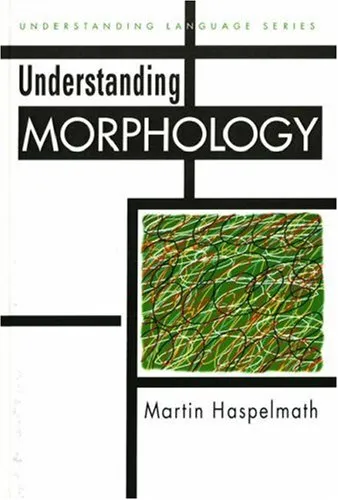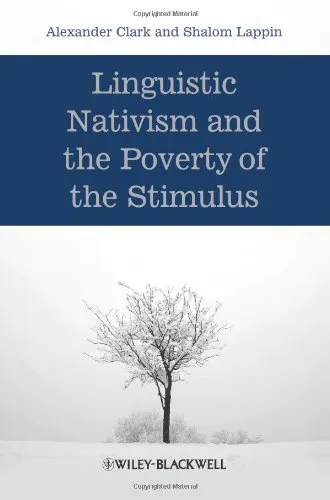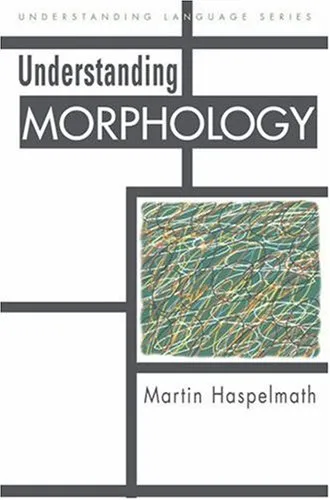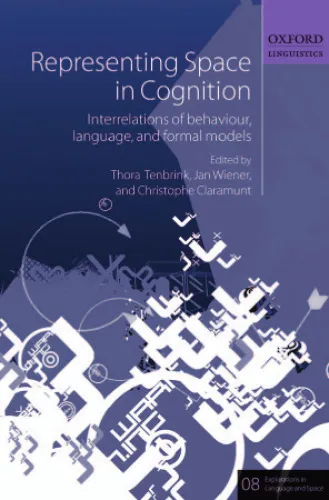Understanding Morphology (Understanding Language)
4.5
بر اساس نظر کاربران

شما میتونید سوالاتتون در باره کتاب رو از هوش مصنوعیش بعد از ورود بپرسید
هر دانلود یا پرسش از هوش مصنوعی 2 امتیاز لازم دارد، برای بدست آوردن امتیاز رایگان، به صفحه ی راهنمای امتیازات سر بزنید و یک سری کار ارزشمند انجام بدینکتاب های مرتبط:
معرفی کتاب «Understanding Morphology»
کتاب «Understanding Morphology» نوشته مارتین هسپلماث یکی از آثار برجسته در حوزه زبانشناسی است که به بررسی دقیق و جامع morphology و تأثیرات آن در زبانهای مختلف میپردازد. این کتاب از سری کتابهای "Understanding Language" است و یک نگاه جامع و تفصیلی به ساختارها و پدیدههای زبانی ارائه میدهد.
خلاصه کتاب
این کتاب به طور خاص بر روی مسائل پایهای مباحث morphology تمرکز دارد و خوانندگان را با راهبردها و مفاهیمی که در تحلیل واژهها و ساختهای آنها مطرح میشود، آشنا میکند. در ابتدای کتاب، تفاوتهای میان واژههای ساده (simple words)، مشتقشده (derived words)، و ترکیبی (compound words) به تفصیل توضیح داده شده است.
بخشهای دیگر کتاب شامل مباحث مهمی مانند تفاوت میان inflection و derivation، بررسی morphemes، قواعد allomorphy، و همچنین روابط میان syntax و morphology میشود. این کتاب تلاش میکند مفاهیم پیچیده را به زبانی سادهتر و قابل درک حتی برای خوانندگانی که تازهوارد به این حوزه هستند، تشریح کند.
آخرین بخشها به موضوعات پیشرفتهتری همچون مشکلات نظری که در مطالعات morphology به وجود میآید، اختصاص دارد. از جمله درک نقش context در درک پدیدههای زبانی و چگونگی انطباق میان زبانهای مختلف در سطح morphological.
نکات کلیدی کتاب
- تبیین مفاهیم پایهای مانند morphemes و allomorphy.
- تفاوتهای میان derivational و inflectional processes.
- چگونگی تحلیل ساختار واژهها در زبانهای مختلف.
- رویکردهای بینزبانی (cross-linguistic approaches) به morphology.
- اهمیت context در تحلیل morphological phenomena.
جملات معروف از کتاب
"Morphology is not just about the building blocks of language, but also about how these blocks interact with larger units of meaning."
"In understanding morphology, one gains insight into the very mechanics of linguistic diversity."
چرا این کتاب مهم است؟
این کتاب یکی از منابع کلیدی برای زبانشناسان، دانشجویان حوزه زبانشناسی، و همچنین علاقهمندانی است که به دنبال فهم عمیقتری از ساختارهای زبانی هستند. «Understanding Morphology» با ارائه مثالهای زیاد و توضیحات شفاف، کمک میکند تا مفاهیم پیچیدهای مانند morphemes و قواعد morphological به زبان سادهتر بیان شوند و مخاطبان با رویکردهای مختلف این حوزه آشنا شوند.
اهمیت دیگر این اثر در این است که به توضیح تفاوتهای مهم زبانهای مختلف جهان و نحوه استفاده از morphology در تحلیلهای متنوع زبانی میپردازد. این کتاب ابزاری قدرتمند برای تحلیل واژگان و زبان بهشمار میرود و برای زبانشناسان کاربردی است.
Introduction to Understanding Morphology (Understanding Language)
Morphology, the study of word structure, serves as an essential pillar of linguistics, bridging the gap between sounds, forms, and meanings in human language. In Understanding Morphology, Martin Haspelmath offers a comprehensive, accessible exploration of morphological theory and its practical applications in linguistic analysis.
The book is invaluable to students, teachers, and language enthusiasts who seek to demystify the complexity of linguistic forms and structures. It provides a detailed discussion of key themes in morphology, such as word formation, inflection, derivation, morphological typology, and the interplay of syntax and semantics within words. Written with clarity and precision, this text equips readers with the tools to engage critically with language data while fostering an appreciation for the diversity of the world's languages.
Detailed Summary of the Book
Understanding Morphology begins by introducing the reader to the basics of morphological analysis and linguistic concepts. Through carefully constructed examples and exercises, the book walks readers through the processes that shape words and meanings. It highlights universal and language-specific morphological patterns, guiding readers to recognize both regularities and exceptions across languages.
Some of the key highlights of the book include:
- An in-depth discussion of word structure, including the distinction between inflectional and derivational morphology.
- Clear explanations of morphological rules and principles, such as affixation, compounding, and reduplication.
- An exploration of cross-linguistic diversity with practical insights into morphological typology.
- Illustrations of how morphology interacts with syntax, phonology, and semantics in diverse languages.
- Practical explorations of analytic vs. synthetic approaches in morphology and the balance between rules and irregularity in paradigms.
Each chapter builds on the previous one, culminating in an enriched understanding of morphology. Additionally, exercises at the end of each chapter allow readers to test their grasp of fundamental concepts by analyzing actual linguistic data.
Key Takeaways
Here are some of the main concepts and lessons that readers can expect to learn from Understanding Morphology:
- The Nature of Morphological Units: Explore morphemes, stems, affixes, and their roles in word formation.
- Differentiating Inflection and Derivation: Understand the functional versus lexical aspects of morphology and their linguistic effects.
- Cross-Linguistic Perspectives: Appreciate the morphological diversity in languages around the globe and how typological differences shape grammar systems.
- Interaction with Syntax and Semantics: Learn about the connections between morphology, syntactic structure, and word meaning.
- Analyzing Real Data: Develop the ability to recognize and analyze morphological phenomena in everyday languages, supported by practical examples and problem-solving techniques.
Famous Quotes from the Book
"Morphology is the study of how meaningful elements combine to form words, and how those words express meaning within a language system."
"The forms and structures we see in language are not random; they reflect systematic principles that allow humans to communicate across diverse contexts and cultures."
"By engaging deeply with morphology, we uncover the rules that underpin linguistic creativity and the ways in which languages evolve."
Why This Book Matters
Morphology is a cornerstone of modern linguistics, and this book offers an unparalleled introduction to the subject. Here's why Understanding Morphology is so impactful:
- Clarity and Accessibility: The book is meticulously written to ensure that even those new to linguistics can grasp complex topics with ease.
- Comprehensive Coverage: It covers essential aspects of morphology while providing real examples from a wide variety of languages, ensuring broad understanding.
- An Interdisciplinary Approach: Rich discussions on the relationships between morphology, syntax, and semantics make it invaluable for linguists and students in related fields.
- Wide Application: The book’s principles can be applied to language studies, computational linguistics, psycholinguistics, and typological research.
- Diversity-Driven: By incorporating examples and insights from numerous languages, it highlights the rich diversity of human linguistic expression, fostering a sense of awe and appreciation for global languages.
Whether you are a beginner exploring the field of linguistics or an advanced student seeking to hone your morphological analysis skills, this book is an indispensable resource. It bridges theory and practical analysis, offering insights that transform the way we understand and study language.
دانلود رایگان مستقیم
شما میتونید سوالاتتون در باره کتاب رو از هوش مصنوعیش بعد از ورود بپرسید
دسترسی به کتابها از طریق پلتفرمهای قانونی و کتابخانههای عمومی نه تنها از حقوق نویسندگان و ناشران حمایت میکند، بلکه به پایداری فرهنگ کتابخوانی نیز کمک میرساند. پیش از دانلود، لحظهای به بررسی این گزینهها فکر کنید.
این کتاب رو در پلتفرم های دیگه ببینید
WorldCat به شما کمک میکنه تا کتاب ها رو در کتابخانه های سراسر دنیا پیدا کنید
امتیازها، نظرات تخصصی و صحبت ها درباره کتاب را در Goodreads ببینید
کتابهای کمیاب یا دست دوم را در AbeBooks پیدا کنید و بخرید
1458
بازدید4.5
امتیاز0
نظر98%
رضایتنظرات:
4.5
بر اساس 0 نظر کاربران
Questions & Answers
Ask questions about this book or help others by answering
No questions yet. Be the first to ask!














![Studies in Generative Grammar [SGG]; 142](https://s3.refhub.ir/images/thumb/Studies_in_Generative_Grammar__SGG___142_45571.webp)
